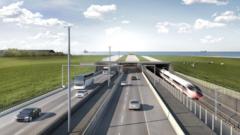The Fehmarnbelt tunnel promises to transform regional transport and boost the economy, with minimal ecological disruption.
**Denmark-Germany Tunnel: A Leap Towards Enhanced Connectivity**

**Denmark-Germany Tunnel: A Leap Towards Enhanced Connectivity**
A landmark project set to revolutionize travel and reduce environmental impact between Denmark and Germany.
A groundbreaking tunnel is currently being constructed under the Baltic Sea to connect Denmark and Germany, promising to significantly reduce travel times while enhancing connections within Scandinavia and across Europe. Spanning an impressive 18 kilometers (approximately 11 miles), the Fehmarnbelt project is set to become the world's longest pre-fabricated road and rail tunnel.
Described as a marvel of engineering, the tunnel will utilize segments placed below the seafloor that will be joined together like puzzle pieces. The primary construction site is located on the north side of Lolland island in Denmark, covering over 500 hectares (about 1,235 acres) and featuring a harbor and manufacturing factory for the tunnel's segments, referred to as "elements."
Henrik Vincentsen, CEO of Femern, the Danish state-owned company responsible for the project, expressed pride in the venture: "It’s a massive facility here... we are breaking records with this project." Unlike traditional underwater tunnels, which typically bore through solid rock, this initiative will assemble 90 elements using reinforced steel and concrete that weigh over 73,000 tonnes each.
With an estimated cost of around €7.4 billion ($8.1 billion; £6.3 billion), most of the funding has come from Denmark, complemented by €1.3 billion from the European Commission. As one of the region's largest infrastructure developments, it aligns with a broader EU strategy to enhance transportation links while minimizing reliance on air travel.
Once completed, travel times between Rødbyhavn in Denmark and Puttgarten in Germany are expected to decrease to just 10 minutes by car or 7 minutes by train, a remarkable reduction from the current 45-minute ferry ride. This new route will also cut travel times between Copenhagen and Hamburg in half, from five hours to 2.5 hours, offering a more environmentally sustainable option for both passengers and freight.
Amid ongoing construction, the project has faced ecological scrutiny, particularly from organizations like Nabu, concerned about the potential impact on local wildlife. However, recent court approvals have allowed the project to proceed, with assurances of minimizing environmental effects through initiatives such as the creation of a 300-hectare wetlands area.
Anticipated to open in 2029, the Fehmarnbelt tunnel is expected to accommodate over 100 trains and 12,000 vehicles daily, funded through tolls that will contribute to covering the construction expenses over the coming decades. Officials believe it will stimulate job growth and economic development in Lolland, a region eager for change. "The locals have been waiting for this project for years," noted Anders Gert Wede, a senior construction manager involved in the project, hinting at a brighter future for the area.






















